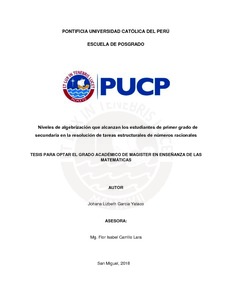| dc.contributor.advisor | Carrillo Lara, Flor Isabel | |
| dc.contributor.author | Garcia Yataco, Johana Lizbeth | es_ES |
| dc.date.accessioned | 2018-07-19T16:39:07Z | es_ES |
| dc.date.available | 2018-07-19T16:39:07Z | es_ES |
| dc.date.created | 2018 | es_ES |
| dc.date.issued | 2018-07-19 | es_ES |
| dc.identifier.uri | http://hdl.handle.net/20.500.12404/12308 | |
| dc.description.abstract | La siguiente investigación analiza los niveles de algebrizacion de estudiantes de primer grado de educación secundaria en la resolución de tareas estructurales, es decir, aquellas tareas que involucran las operaciones y propiedades del conjunto de números racionales que generan el Razonamiento Algebraico Elemental (RAE). Se emplea algunas herramientas teóricas y metodológicas del Enfoque Ontosemiótico de la Cognición e Instrucción Matemática para analizar las soluciones de cuatro tareas estructurales. Se realiza una prueba piloto con cuatro estudiantes de sexto grado de primaria, se propone una configuración cognitiva en la que se muestra las soluciones esperadas por parte de los estudiantes de primer grado de educación secundaria y luego se realiza la configuración instruccional. Tres de las tareas estructurales propuestas tienen como objetivo realizar conjeturas y validaciones que generen procesos de generalización para utilizar variables y una de las tareas tiene como objetivo identificar una situación de contexto de medida. A partir de ello, considerando las características de los rasgos de RAE propuestas por Godino, Castro, Ake y Wilhelmi (2012), identificamos los niveles de algebrizacion de cada tarea. Del análisis de las respuestas, se concluye que predominan las generalizaciones para valores cercanos, ya que los estudiantes manifiestan procedimientos aritméticos. Luego de los resultados, el nivel de algebrización predominante en los estudiantes en cada tarea fue nivel 1, ya que realizan correctamente las propiedades y operaciones, además de realizar generalizaciones. Asimismo, podemos concluir que los estudiantes están listos para avanzar a otro nivel y que sí pueden resolver estos tipos de tarea. Esto se visualiza en las soluciones de los estudiantes que logran alcanzar rasgos del nivel 3 de algebrización, ya que utilizan variables y realizan tratamientos para encontrar un patrón general | es_ES |
| dc.description.abstract | This investigation aims to analyze the levels of algebraization in the resolution of structural tasks among first grade students at secondary level. The selected tasks involve the operation and properties of the set of rational numbers that generate the Elementary Algebraic Reasoning AR.
In order to analyze four structure tasks solutions, some theoretical and methodological tools were used. Specifically, the Onto-Semiotic Approach to Mathematical Knowledge and Instruction. Based on that, a pilot test was run having four sixth grade students from primary school. So, a cognitive configuration is proposed in which the expected solutions from the students are considered and then, the instructional configuration is made. The proposed structural tasks objective from three proposed structural tasks are to make conjectures and validations that generates generalization processes to use variable and one of the tasks is to identify a situation that can allow measure the context, After that and considering the characteristics of AR features proposed by Godino, Castro, Ake and Wihelmi (2012), we identify the algebaization levels of each tasks and on that, the analysis of each student is performed on the four tasks. From the answers analysis which was made. From the Analysis of the answers, this investigation concludes that the generalization for near values or rates are predominant. This can be explained by the fact that the students manifest arithmetic procedures. After the results, the level of predominant algebraization in the students in each task was level 1, since they correctly perform the properties and operations, and also were able to make generalizations. Likewise, we can conclude that students are ready to be promoted to another level and that they can solve these types of tasks. This can be seen in the solutions of the students who manage to reach features of level 3 of algebraization, since they use variables and perform certain procedures to find a general pattern. | es_ES |
| dc.language.iso | spa | es_ES |
| dc.publisher | Pontificia Universidad Católica del Perú | es_ES |
| dc.rights | Atribución-NoComercial-SinDerivadas 2.5 Perú | * |
| dc.rights | info:eu-repo/semantics/openAccess | es_ES |
| dc.rights.uri | http://creativecommons.org/licenses/by-nc-nd/2.5/pe/ | * |
| dc.subject | Matemáticas--Estudio y enseñanza | es_ES |
| dc.subject | Educación secundaria | es_ES |
| dc.title | Niveles de algebrización que alcanzan los estudiantes de primer grado de secundaria en la resolución de tareas estructurales de números racionales | es_ES |
| dc.type | info:eu-repo/semantics/masterThesis | es_ES |
| thesis.degree.name | Magíster en la enseñanza de las Matemáticas | es_ES |
| thesis.degree.level | Maestría | es_ES |
| thesis.degree.grantor | Pontificia Universidad Católica del Perú. Escuela de Posgrado | es_ES |
| thesis.degree.discipline | Enseñanza de las Matemáticas | es_ES |
| renati.discipline | 199117 | es_ES |
| renati.level | https://purl.org/pe-repo/renati/level#maestro | es_ES |
| renati.type | http://purl.org/pe-repo/renati/type#tesis | es_ES |
| dc.publisher.country | PE | es_ES |
| dc.subject.ocde | https://purl.org/pe-repo/ocde/ford#5.03.01 | es_ES |






